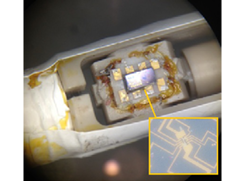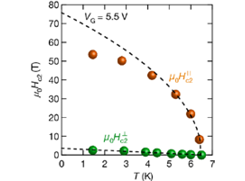Extremely Large and Anisotropic Upper Critical Field inIon-Gated MoS2
Y. Saito, Y. Kohama, and Y. Iwasa
Superconductivity is a quantum phenomenon characterized by zero electrical resistance and complete expulsion of the magnetic flux. The extraordinary properties arise from the condensation of the Cooper pair that consists of a pair of free electrons with opposite spins. The application of strong magnetic fields tends to arrange spins in one direction, therefore the ordinal superconductivity cannot be survived above the certain limit of magnetic fields, called the Pauli limit “HPauli ~ 1.86 Tc”. Nevertheless, our recent collaboration work performed at International MegaGauss Science Laboratory (IMGSL) has experimentally revealed that an ion-gated molybdenum disulphide (MoS2) transistor exhibits an extremely large upper critical field (Hc2) that is 4-5 times more than the Pauli limit of ~ 12 T [1].

Fig. 1. MoS2 EDLT transistor on the rotator probe.

Fig. 2. Upper critical fields (Hc2) vs Temperature (T). The orange and green dots are the Hc2 when the external magnetic fields are applied to parallel (Hc2||) and perpendicular (Hc2⊥) to the plane, respectively. The upper critical fields were deduced from the magnetoresistance measurements.
The Hc2 were directly estimated from the magnetoresistance measurement on superconducting MoS2 samples that were prepared by using an electric-double-layer transistor (EDLT) configuration [2]. Since the Hc2 is extremely large and shows a high degree of anisotropy, we developed a specially designed plastic rotator (see Fig. 1) and performed magnetoresistance measurements in pulsed magnetic fields up to 55 T. The rotator probe was made of a plastic material, and thus the eddy current related problems, such as Joule heating and mechanical vibration, were completely eliminated even in a pulsed field environment.
The obtained Hc2 vs T plot is shown in Fig. 2, which provides the experimental evidence of anisotropic and extremely large upper critical fields on the MoS2-EDLT. We interpret that the large anisotropy can be understood as a consequence of the two-dimensional electric property of MoS2-EDLT, namely the completely different orbital motion for the in-plane and out-of-plane configurations. On the other hand, the exceptionally large Hc2 for the in-plane configuration is due to an enhancement of the Pauli limit, caused by the strong spin-orbit interaction and the non-centrosymmetric nature of MoS2 single layer. Indeed, our numerical calculation based on realistic tight-binding calculations demonstrate that the Cooper pairs are protected by the strong spin-orbit interaction, and are thereby very robust against external magnetic fields for the in-plane configuration. The robustness of Hc2 against external magnetic fields might make MoS2-EDLT an ideal platform for investigating noncentrosymmetric superconductors.
References
- [1] Y. Saito, Y. Nakamura, M. S. Bahramy, Y. Kohama, J. T. Ye, Y. Kasahara, Y. Nakagawa, M. Onga, M. Touanga, T. Nojima, Y. Yanase, and Y. Iwasa, Nature Physics 12, 144 (2016).
- [2] J. T. Ye, Y. J. Zhang, R. Akashi, M. S. Bahramy, R. Arita, and Y. Iwasa, Science 338, 1193 (2012).
